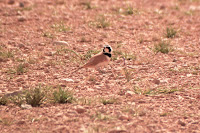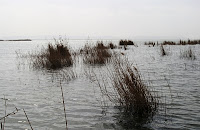

Shortly after first light, we were at Sed Wadi Abyed, a lake 10 km north of Palmyra. We worked along the lake shore, in and out of the bands of Tamarisk while keeping an eye on the high cliffs on each side. Chiffchaffs were everywhere, along with a few Bluethroats, Water Pipits and Lesser Whitethroat. Overhead were Red-billed Chough, Alpine, Pallid and Common Swifts. An excellent site for migrants and one we must return to.
Driving north through some amazingly desolate and stunning scenery, Housam screached to a halt. We assumed he had spotted something good. Well in a way he had; a shovel lying by the side of the road which was quickly put into the boot. We arrived back at Lake Jubbal by lunchtime, and back searching for SPs. We found just 3, all on fallow within arable land, a contrast to the usual steppe habitat. The fallow has a sparse flora and is very stoney. Lake Jubbal measures an impressive 220,000 ha. Wildfowl seem almost impossible to count; in one bay we managed 156 White-headed Ducks, 630 Shoveler and 750 Pochard.
With the fine sunny weather today, birds were definitely on the move. By the end of the afternoon, 1200 Cranes had arrived at the lake, the whooping calls of each successive flock announcing their arrival, and audible at around a mile distant.
We walked out to the lake at dawn the following morning from Yaseem's house, where we again slept communally on the floor. It was a cold night but day dawned bright and we were soon looking at around 1,850 White-headed Ducks, perhaps 25% of the world population. As the sun warmed the morning, the Cranes that had roosted on the lake overnight began to lift off and circle up, all with loud bugleing calls. We counted 3,613 in all, wave after wave passing over us heading north.
By a stroke of luck we met Abu Said, a sheep farmer, at lunchtime. Bread with sheep's yogurt, cheese, butter and colostrum, all freshly made that morning, were promptly laid out. Served with camomile tea of course.


























